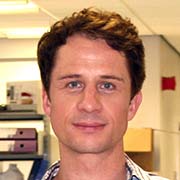 Dr Thorsten Allers graduated from the University of Cambridge and his research career has focussed on DNA replication, recombination and repair.
Dr Thorsten Allers graduated from the University of Cambridge and his research career has focussed on DNA replication, recombination and repair.
He has exploited model organisms from the three domains of life – Bacteria, Eukarya and Archaea. His PhD with David Leach (University of Edinburgh) was concerned with DNA repeats that are targeted by the Escherichia coli machinery for recombination. For his postdoctoral fellowship with Michael Lichten (NIH, USA), he switched to Saccharomyces cerevisiae and made the discovery that crossover and non-crossover products of homologous recombination are formed by different mechanisms.
In 2001, he was awarded a Royal Society University Research Fellowship to establish his group at the University of Nottingham. His laboratory has developed a tractable genetic system for Archaea using the halophile Haloferax volcanii, which they have used to study how DNA replication, repair and recombination operate in the third domain of life.
Life Without DNA Replication Origins
DNA replication is initiated at specific chromosomal sites called origins, which serve as binding sites for proteins that recruit the replicative enzymes. Replication origins are assumed to be an essential part of the DNA replication apparatus but we have shown that in the archaeon Haloferax volcanii, life without origins is not only possible but highly efficient.
The replication enzymes found in archaea and eukaryotes differ fundamentally from those in bacteria; due to their shared evolutionary history, the former two are highly similar. For example, the archaeo-eukaryotic replicative helicase MCM is distinct to the bacterial replicative helicase DnaB, and the two complexes migrate in different directions on DNA. By contrast, the key enzyme for homologous recombination – known as RecA in bacteria, RadA in archaea and Rad51 in eukaryotes – is conserved in all domains. If homologous recombination is an ancestral process that predates the split between bacteria, archaea and eukaryotes, and the evolution of their different machineries for DNA replication, could it have been used to initiate replication in the last common ancestor?
We have shown that in the archaeon Haloferax volcanii, deletion of all chromosomal origins leads to the initiation of all DNA replication by homologous recombination. Similar results have been obtained with deletion mutants lacking Orc1/Cdc6 replication initiator proteins, which are required for origin firing. Surprisingly, this leads to accelerated growth with no obvious defects, whereas deletion of origins (or initiator protein genes) in yeast or Escherichia coli leads to severe growth impairment. If homologous recombination alone can efficiently initiate the replication of an entire cellular genome, what purpose do replication origins serve and why they have evolved?